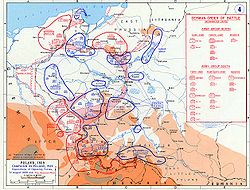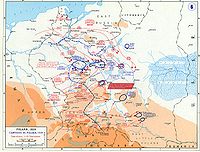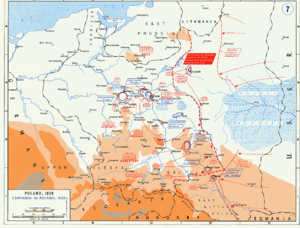
Warszawa Army
Encyclopedia
The Warszawa Army was one of the Polish armies to take part in the Polish Defensive War
of 1939. Created on 8 September, eight days after the invasion begun, it was an improvised formation charged with the defence of the Polish capital of Warsaw
(Warszawa).


 To defend the Polish capital Warsaw in the face of breakthrough by the German forces.
To defend the Polish capital Warsaw in the face of breakthrough by the German forces.
, ordered general Walerian Czuma
(the Commander of the Border Guards - Straż Graniczna) to organize a force to defend the city of Warsaw against a German attack. The city had been under constant attack by the Luftwaffe
since the early morning of 1 September. Initially the only organized units available to him were four infantry battalions, anti-aircraft artillery and anti-aircraft machine guns detachments under colonel Kazimierz Baran, composed mostly of fire-fighter brigades and volunteers supervised by colonel Tadeusz Bogdanowicz and Julian Kulski
, the deputy president of Warsaw
. The AA artillery had 86 pieces of anti-aircraft artillery, as well as an unknown number of anti-aircraft machine guns. In addition there was an air force Pursuit Brigade
which was equipped with 54 fighter aircraft. On the 5 and 6 September the air force and 11 batteries of anti-aircraft artillery were withdrawn to Lublin
.
Initially however parts of various army units, primarily of Łódź Army, retreating before the onslaught of German armor units, were added to his force.
On 8 September General Juliusz Rómmel
, the commander of the Łódź Army who had become separated from his operational units, arrived in Warsaw with his staff. The chief of staff of the Polish Armed Forces
, general Wacław Stachiewicz (then in Brześć), appointed him the overall commander of all forces defending Warsaw, including the Warsaw Defense Force, the Modlin Fortress
and the army units immediately south and north-east of Warsaw
During the next days, army units retreating in face of the onslaughts of the German armor and under continuous air attacks, fought their way through the German lines to the besieged capital, in particular from the Battle of Bzura. After 13 September Warsaw and Modlin were effectively surrounded. The only way the Polish units were able to reach the besieged area was through the Kampinos Forest
between Warsaw and the Vistula river. On 22 September German forces cut through the remaining lines of communication between Warsaw and Modlin.
On 26 September, after heavy bombardment had cut off water and the civilian population was starving, the city was forced to surrender. On 28 September the Polish forces in Warsaw capitulated; fort Modlin capitulated the following day.
Chief of staff: col Aleksander Pragłowski
Deputy Commander: General Tadeusz Kutrzeba
, was commander of Army Poznan - reached Warsaw 16 September.
Commander of Warsaw Garrison: Walerian Czuma
,
Elements of Army Poznań
Elements of Army Pomorze
(originally Commander of 5th Infantry Division)
Elements of Army Modlin
- after 12 September.
Elements of Modlin Army
Elements of Poznań Army
and Pomorze Army
remains arrived from the Battle of Bzura after 18 September.
Elements of Łódź Army arrived on 13 September.
Invasion of Poland (1939)
The Invasion of Poland, also known as the September Campaign or 1939 Defensive War in Poland and the Poland Campaign in Germany, was an invasion of Poland by Germany, the Soviet Union, and a small Slovak contingent that marked the start of World War II in Europe...
of 1939. Created on 8 September, eight days after the invasion begun, it was an improvised formation charged with the defence of the Polish capital of Warsaw
Warsaw
Warsaw is the capital and largest city of Poland. It is located on the Vistula River, roughly from the Baltic Sea and from the Carpathian Mountains. Its population in 2010 was estimated at 1,716,855 residents with a greater metropolitan area of 2,631,902 residents, making Warsaw the 10th most...
(Warszawa).
Tasks



Operational history
On 3 September 1939 the Minister of the Army (Min. Spraw Wojskowych), general Tadeusz KasprzyckiTadeusz Kasprzycki
Tadeusz Kasprzycki was a member of the Polish Legions in First World War, general of the Polish Army from 1929 and Minister of Military Affairs of Poland from 1935 to 1939....
, ordered general Walerian Czuma
Walerian Czuma
Walerian Czuma was a Polish general and military commander. He is notable for his command over a Polish unit in Siberia during the Russian Civil War and the commander of the defence of Warsaw during the siege of that city in 1939.-Biography:...
(the Commander of the Border Guards - Straż Graniczna) to organize a force to defend the city of Warsaw against a German attack. The city had been under constant attack by the Luftwaffe
Luftwaffe
Luftwaffe is a generic German term for an air force. It is also the official name for two of the four historic German air forces, the Wehrmacht air arm founded in 1935 and disbanded in 1946; and the current Bundeswehr air arm founded in 1956....
since the early morning of 1 September. Initially the only organized units available to him were four infantry battalions, anti-aircraft artillery and anti-aircraft machine guns detachments under colonel Kazimierz Baran, composed mostly of fire-fighter brigades and volunteers supervised by colonel Tadeusz Bogdanowicz and Julian Kulski
Julian Kulski
Julian Kulski was a civil servant, best known for being President of Warsaw during World War II....
, the deputy president of Warsaw
President of Warsaw
The Mayor of Warsaw, or more properly the President of Warsaw is the head of the capital of Poland....
. The AA artillery had 86 pieces of anti-aircraft artillery, as well as an unknown number of anti-aircraft machine guns. In addition there was an air force Pursuit Brigade
Pursuit Brigade
The Pursuit Brigade was a Polish World War II unit of the Polish Air Force. It took part in the Polish Defensive War of 1939 as the main aerial reserve of the commander in chief and was used for air cover of the Polish capital of Warsaw. It was similar in shape to the Bomber Brigade...
which was equipped with 54 fighter aircraft. On the 5 and 6 September the air force and 11 batteries of anti-aircraft artillery were withdrawn to Lublin
Lublin
Lublin is the ninth largest city in Poland. It is the capital of Lublin Voivodeship with a population of 350,392 . Lublin is also the largest Polish city east of the Vistula river...
.
Initially however parts of various army units, primarily of Łódź Army, retreating before the onslaught of German armor units, were added to his force.
On 8 September General Juliusz Rómmel
Juliusz Rómmel
Juliusz Karol Wilhelm Józef Rómmel was a Polish military commander and a general of the Polish Army. During the Polish-Bolshevik War, he gained great fame for achieving a decisive victory in the Battle of Komarów, the largest cavalry engagement of the 20th century...
, the commander of the Łódź Army who had become separated from his operational units, arrived in Warsaw with his staff. The chief of staff of the Polish Armed Forces
Polish Armed Forces
Siły Zbrojne Rzeczypospolitej Polskiej are the national defense forces of Poland...
, general Wacław Stachiewicz (then in Brześć), appointed him the overall commander of all forces defending Warsaw, including the Warsaw Defense Force, the Modlin Fortress
Modlin Fortress
Modlin Fortress is one of the biggest 19th century fortresses in Poland. It is located the town of Nowy Dwór Mazowiecki in district Modlin on the Narew river, some 50 kilometres north of Warsaw...
and the army units immediately south and north-east of Warsaw
During the next days, army units retreating in face of the onslaughts of the German armor and under continuous air attacks, fought their way through the German lines to the besieged capital, in particular from the Battle of Bzura. After 13 September Warsaw and Modlin were effectively surrounded. The only way the Polish units were able to reach the besieged area was through the Kampinos Forest
Kampinos Forest
Kampinos Forest is a large forest complex located to the west of Warsaw in Poland. It covers a large part of the ancient valley of Vistula, between Vistula and Bzura rivers. Once a gigantic forest covering 670 km² of central Poland, it currently covers roughly 240 km².Most of the...
between Warsaw and the Vistula river. On 22 September German forces cut through the remaining lines of communication between Warsaw and Modlin.
On 26 September, after heavy bombardment had cut off water and the civilian population was starving, the city was forced to surrender. On 28 September the Polish forces in Warsaw capitulated; fort Modlin capitulated the following day.
Units
Commander: General Juliusz RómmelJuliusz Rómmel
Juliusz Karol Wilhelm Józef Rómmel was a Polish military commander and a general of the Polish Army. During the Polish-Bolshevik War, he gained great fame for achieving a decisive victory in the Battle of Komarów, the largest cavalry engagement of the 20th century...
Chief of staff: col Aleksander Pragłowski
Deputy Commander: General Tadeusz Kutrzeba
Tadeusz Kutrzeba
Tadeusz Kutrzeba was an army general of the Second Polish Republic.Kutrzeba was born in Kraków, then part of Austria-Hungary...
, was commander of Army Poznan - reached Warsaw 16 September.
Commander of Warsaw Garrison: Walerian Czuma
Walerian Czuma
Walerian Czuma was a Polish general and military commander. He is notable for his command over a Polish unit in Siberia during the Russian Civil War and the commander of the defence of Warsaw during the siege of that city in 1939.-Biography:...
Warsaw West
Commander: General Walerian CzumaWalerian Czuma
Walerian Czuma was a Polish general and military commander. He is notable for his command over a Polish unit in Siberia during the Russian Civil War and the commander of the defence of Warsaw during the siege of that city in 1939.-Biography:...
,
- 40th Infantry Regiment "Children of Lwów" (Lt.Col. Józef Kalandyk} - transport through Warsaw stopped 7 September.
- Legia Akademicka (Academic Legion) - made up of students of the universities.
- Volunteer Units
Elements of Army Poznań
- 25th Infantry Division. (Gen. Franciszek Alter) - elements fight through enemy lines 20 September.
- 14 Cavalry Ulan Regiment (Col. Edward Godlewski) - 431 survivors charge through enemy lines 19 September
- Podole Cavalry Brigade (Col. Leon Strzelecki) - fights through German lines 20 September
- Wielkopolska Cavalry Regiment (Gen. Roman Abraham) - fights through enemy lines 20 September.
Elements of Army Pomorze
- 15th Infantry Division, (Gen. Zdzislaw Przyjalkowski) - 1500 survivors fight through 22 September.
- Pomorze Cavalry Brigade (Col. Adam Bogoria-Zakrzewski) - survivors fight through 20 September.
Warsaw East
Commander: 5 September Lt.Col. Julian Janowski; from 15 September Gen. Juliusz ZulaufJuliusz Zulauf
Juliusz Zulauf was a Polish Army major general . A recipient of the Virtuti Militari, he fought with distinction during World War I, the Polish-Ukrainian War, the Polish-Soviet War, and the 1939 invasion of Poland.Juliusz Zulauf was born in Lwów, then the capital of Austro-Hungarian Galicia...
(originally Commander of 5th Infantry Division)
Elements of Army Modlin
- 5th Infantry Division (Gen. Juliusz Zulauf) retreated from river Narew front 13 September.
- 20th Infantry Division (Col. Wilhelm Andrzej Lawicz-Liszka) - arrived from north 15 September
- 21st Infantry Regiment "Children of Warsaw" (Col. Stanisław Sosabowski) - separated from 8th Infantry Division, arrived 21 September.
Modlin Fortress
Commander: Gen.Wiktor ThomméeWiktor Thommée
Wiktor Thommée was a Polish military commander and a Brigadier General of the Polish Army. A veteran of the Great War and the Russian Civil War, he is best known for his command over Piotrków Operational Group and the battle of the Bzura during the Polish Defensive War of 1939.- Early life :Wiktor...
- after 12 September.
Elements of Modlin Army
Modlin Army
Modlin Army was one of the Polish armies that took part in the Polish Defensive War of 1939. After heavy casualties in the battle of Mława , the Army was forced to abandon its positions near Warsaw around September 10; eventually it took part in the battle of Tomaszów Mazowiecki and surrendered...
- 5th Infantry Division - some elements retreated from battle near Dębe on Narew river - 14 Sept
- 8th Infantry Division (Col. Teodor Wiktor Furgalski) - remains of division after retreat from north (mainly 32 Inf.Reg. and some units of artillery) - from 8 September
Elements of Poznań Army
Poznan Army
Army Poznań led by mj. gen. Tadeusz Kutrzeba was one of the Polish Armies during the Polish Defensive War in 1939.-Tasks:Flanked by Armia Pomorze to the north and Armia Łódź to the south, the Army was to provide flanking operations in Grand Poland region, defend it and withdraw towards lines of...
and Pomorze Army
Pomorze Army
The Pomeranian Army was one of the Polish armies to take part in the Polish Defensive War of 1939. It was officially created on March 23, 1939. Led by Gen.dyw...
remains arrived from the Battle of Bzura after 18 September.
- 36th Infantry Regiment
Elements of Łódź Army arrived on 13 September.
- 30th Infantry Division (Gen. Leopold Cehak)
- Wołyńska Cavalry Brigade (col. Julian Filipowicz)
See also
- List of Polish armies in World War II
- Łódź Army
- Siege of Warsaw (1939)Siege of Warsaw (1939)The 1939 Battle of Warsaw was fought between the Polish Warsaw Army garrisoned and entrenched in the capital of Poland and the German Army...
- Battle of ModlinBattle of ModlinThe Battle of Modlin took place during the German invasion of Poland at the beginning of the Second World War. Modlin Fortress was initially the headquarters of the Modlin Army until its retreat eastwards. From 13 September to 29 September in 1939 it served as a defensive citadel for Polish forces...

